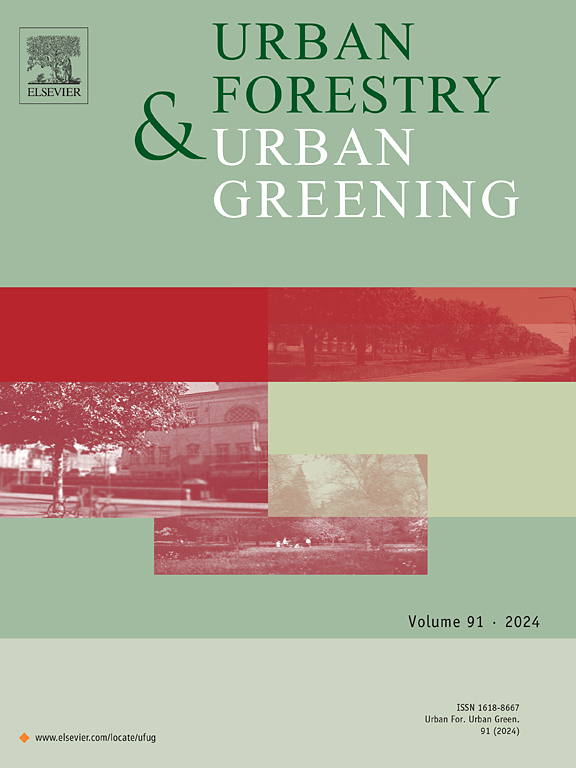Unirrigated extensive green roofs in humid subtropics – Plant selection and substrate design for low maintenance and climate resilience
IF 6
2区 环境科学与生态学
Q1 ENVIRONMENTAL STUDIES
引用次数: 0
Abstract
Low-maintenance extensive green roofs hold the potential for adapting to climate change, but there is a limited understanding of their effective design in humid subtropical regions. In this study, we aimed to investigate low-maintenance green roof ecosystems capable of thriving under heat stress. Plant growth performance was evaluated in the second year of an experimental green roof in southwest China. This green roof was unirrigated and involved two plant communities (forbs and grasses) cultivated in four substrate types. Metrics of growth performance, including plant survival, green coverage, visual appearance, leaf stomatal conductance, and substrate volumetric water content were used to analyze the impact of substrate on plant growth. ESP substrate, comprising 30 %v (percent of volume) expanded shale, 25 %v perlite, 25 %v vermiculite, and 20 %v compost, featured the highest porosity and optimal growth of forbs, achieving an average green coverage of 66.76 % and average visual appearance value of 3.56 throughout the monitoring period. The high total porosity of this substrate could be critical in facilitating root development and drainage. Moreover, during the summer’s heat and drought, while substrate water content is not a limiting factor for the survival of some established forbs, it remains crucial for the growth of grasses. Additionally, the same substrate impacts different plant communities variably. Four particularly well-performing forb species, namely Lycoris chinensis, Tradescantia pallida, Liriope muscari, and Salvia farinacea, demonstrated survival rates closed to 100 % and an average visual appearance value exceeding 3 was noted, and thus, they are recommended as plant candidates for unirrigated green roofs. The distinguished performance of these species is attributable to their adaptation to heat and drought through specific physiological traits. Our findings provide insights into vegetation selection and substrate optimization for the successful establishment of extensive green roofs that could be feasibly developed without irrigation in the humid subtropical regions.
亚热带潮湿地区的非灌溉大面积绿色屋顶--植物选择和基质设计,以实现低维护和气候适应性
低维护的大面积绿色屋顶具有适应气候变化的潜力,但人们对其在亚热带潮湿地区的有效设计了解有限。在这项研究中,我们旨在调查能够在热应力下茁壮成长的低维护屋顶绿化生态系统。在中国西南部的一个实验性绿色屋顶的第二年,我们对植物的生长性能进行了评估。该屋顶绿化没有灌溉系统,涉及在四种基质中栽培的两种植物群落(牧草和禾本科植物)。生长性能指标包括植物存活率、绿化覆盖率、视觉外观、叶片气孔导度和基质体积含水量,用于分析基质对植物生长的影响。由 30%v (体积百分比)膨胀页岩、25%v 珍珠岩、25%v 蛭石和 20%v 堆肥组成的 ESP 基质孔隙率最高,草本植物生长最佳,在整个监测期间的平均绿色覆盖率为 66.76%,平均视觉外观值为 3.56。这种基质的高总孔隙率对于促进根系生长和排水至关重要。此外,在炎热干旱的夏季,虽然基质含水量并不是一些草本植物存活的限制因素,但它对草本植物的生长仍然至关重要。此外,同一基质对不同植物群落的影响也各不相同。四种表现特别好的禁草物种,即Lycoris chinensis、Tradescantia pallida、Liriope muscari和Salvia farinacea,存活率接近100%,平均视觉外观值超过3,因此被推荐为无灌溉屋顶绿化的候选植物。这些物种的优异表现归功于它们通过特定的生理特性对高温和干旱的适应。我们的研究结果为植被选择和基质优化提供了启示,有助于在亚热带湿润地区成功建立无需灌溉的大面积屋顶绿化。
本文章由计算机程序翻译,如有差异,请以英文原文为准。
求助全文
约1分钟内获得全文
求助全文
来源期刊

Urban Forestry & Urban Greening
FORESTRY-
CiteScore
11.70
自引率
12.50%
发文量
289
审稿时长
70 days
期刊介绍:
Urban Forestry and Urban Greening is a refereed, international journal aimed at presenting high-quality research with urban and peri-urban woody and non-woody vegetation and its use, planning, design, establishment and management as its main topics. Urban Forestry and Urban Greening concentrates on all tree-dominated (as joint together in the urban forest) as well as other green resources in and around urban areas, such as woodlands, public and private urban parks and gardens, urban nature areas, street tree and square plantations, botanical gardens and cemeteries.
The journal welcomes basic and applied research papers, as well as review papers and short communications. Contributions should focus on one or more of the following aspects:
-Form and functions of urban forests and other vegetation, including aspects of urban ecology.
-Policy-making, planning and design related to urban forests and other vegetation.
-Selection and establishment of tree resources and other vegetation for urban environments.
-Management of urban forests and other vegetation.
Original contributions of a high academic standard are invited from a wide range of disciplines and fields, including forestry, biology, horticulture, arboriculture, landscape ecology, pathology, soil science, hydrology, landscape architecture, landscape planning, urban planning and design, economics, sociology, environmental psychology, public health, and education.
 求助内容:
求助内容: 应助结果提醒方式:
应助结果提醒方式:


